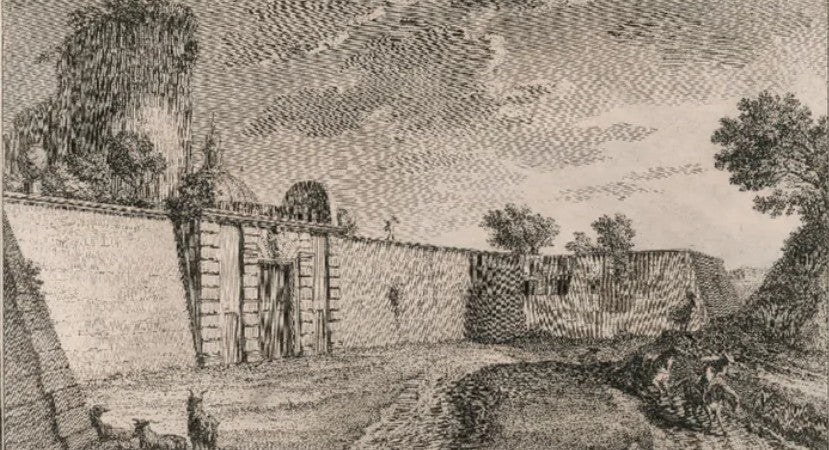
Pertusa Door of Vases
Alice PettirossoShare
Summary of the work and historical context
Porta Pertusa is an engraving that fascinates for its richness of detail and the meticulousness with which it represents 18th-century Rome . Created by the famous engraver and architect Giuseppe Vasi , the work is part of the monumental series Delle Magnificenze di Roma antica e moderna , composed of ten volumes published between 1747 and 1761. Vasi had an ambitious goal: to document every aspect of the eternal city , not only as a catalogue of monuments, but as a lively urban portrait that captures the essence of daily life at the time.
The engraving depicts the Porta Pertusa , a small and little-known opening in the Leonine Walls , near the Vatican . Vasi does not simply depict the architecture of the gate, but places it in a broader context, showing the surrounding streets, the activities of the people and the urban landscape. This approach reflects his desire to offer a complete and authentic vision of Rome , highlighting both the grandeur of its monuments and the vitality of its people.
Structure of the work
Imagine yourself in front of a scene teeming with life : Porta Pertusa is a passageway animated by human figures engaged in their daily activities. At the center of the engraving, the door opens between the walls, with its simple but imposing structure. The walls extend to the sides, creating a balanced composition that guides the observer's gaze through the image.
In the foreground, Vasi meticulously depicts people walking , traders with their carts and pack animals, creating a visual narrative of city life . In the background, buildings and details of the urban landscape can be glimpsed, adding depth and placing the scene in the Roman topography . This attention to everyday life gives the work an engaging realism .
Engraving technique
Giuseppe Vasi is renowned for his mastery of the art of etching . In Porta Pertusa , he expertly uses thin lines and cross-hatching to create texture and depth. The precision with which he draws every stone of the walls and every tile of the roofs reveals his architectural training and his keen eye for detail .
The use of shadows is studied to highlight the volumes of the buildings and the three-dimensionality of the scene. The human figures, although minute compared to the architecture, are carefully outlined, showing postures and clothes that add historical authenticity . The combination of these technical elements makes the engraving not only a topographical document , but also a work of art capable of capturing the atmosphere of eighteenth-century Rome .
Curiosities about the work
An interesting aspect of Porta Pertusa is Vasi 's choice to depict a lesser-known gate in the Roman walls. Porta Pertusa , whose name means "perforated gate" or "opening," was used primarily as a secondary passageway near the Vatican . The decision to include it in his series highlights Vasi 's intent to document not only the city's most famous monuments, but also its hidden and less celebrated corners .
The work also offers a glimpse of the social life of the time . The activities depicted – trade, meetings, travellers in transit – reflect the daily life of 18th-century Romans and allow the modern observer to immerse themselves in the atmosphere of the time.
Giuseppe Vasi: an artist dedicated to the eternal city
Giuseppe Vasi (1710-1782) was one of the most important engravers and topographers of his time . Originally from Sicily, he moved to Rome , where he developed a deep passion for the city and its structures. His main work, Delle Magnificenze di Roma antica e moderna , represents an irreplaceable testimony of eighteenth-century Rome , precisely documenting over 200 views of monuments , churches, squares and streets.
Vasi was also the teacher of Giovanni Battista Piranesi , significantly influencing the training of his pupil. However, while Piranesi tended to emphasize the grandiose and fantastic aspects of Roman architecture, Vasi remained faithful to a more realistic and detailed representation. His attention was focused on topographical accuracy and historical documentation , without neglecting the artistic aspect that makes his engravings of great aesthetic value.
Vasi 's contribution goes beyond the art of engraving: through his works, he has preserved for future generations the image of a Rome in continuous evolution , capturing moments of life otherwise destined to be lost in time. His dedication to the eternal city has made his work a precious source for historians, architects and lovers of Roman art.

